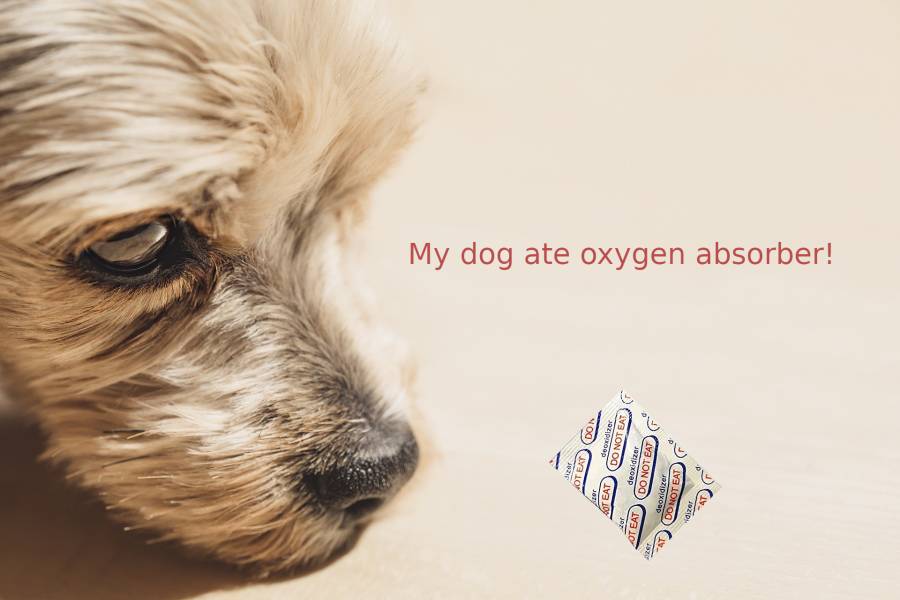Quick Navigation
Iron poisoning is common in dogs. One of the ways a dog gets poisoned is through the consumption of oxygen absorbers.
Oxygen absorbers are small packets of iron granules found in dehydrated or pre-prepared foods.

These packaged foods include beef jerky, pepperoni, and dried fruits.
Oxygen absorbers prevent dried foods from turning rancid or oxidizing. They also preserve freshness.
What Are The Dangers Of Dogs Eating Oxygen Absorbers?
Oxygen absorbers or iron granules are magnetic black substances.
An oxygen absorber is poisonous and can cause serious health issues, even when your dog eats a small amount.
Iron poisoning in dogs, if not treated, may even lead to death.
However, a lot of oxygen absorbers have reduced iron as their active ingredient.
This way, it is less toxic and cannot lead to iron poisoning. Sometimes, dogs do not show any sign of iron poisoning even when eaten.
It is because some oxygen absorbers are either non-toxic or consumed in small amounts.
There are signs you should watch out for when your dog eats an oxygen absorber. One of which is vomiting.
Your dog might vomit with or without blood. It is necessary to look out for this sign to be sure that your pet ate it.
Hepatic exposure and shock are experiences your dog may have if it ingests an oxygen absorber in large quantities.
If your dog ate more than 60 mg of iron, then it can cause life-threatening toxicity.
Ingestion between 5 to 20 mg might cause mild toxicity.
Symptoms And Stages Of Oxygen Absorber Poisoning In Dogs
Your dog goes through four stages when they have iron poisoning.
In The First Stage
Your dog will experience gastrointestinal problems such as diarrhea and vomiting; it happens in the first 6 hours.
These symptoms include pain and swelling in the abdomen, weight loss, shock, seizures, loss of appetite, agitation, fast heartbeat, low blood pressure, tiredness, shock, and seizure.
The Second Stage
During the second stage, your pet seems to feel better.
It happens between 6 and 24 hours. All the symptoms seem to disappear.
The Third Stage
Your dog starts to display clinical symptoms between 12 and 96 hours.
These symptoms include bloody diarrhea, shock, seizures, muscle tremor, and a quick heart rate.
He may also lose appetite and weight, have abdominal pain, organ damage, and collapse.
It may lead to death if not treated immediately.
If you suspect your dog has consumed a high amount of iron, please consult a vet.
The Fourth Stage
The symptoms include liver damage and jaundice. In this stage, your dog’s eyes and skin turn yellow.
Dogs may experience bloody diarrhea and intestinal blockages from strictures.
Your Dog Eats An Oxygen Absorber – What Next?
Once you suspect your dog has consumed an oxygen absorber, you must not induce vomiting. It can cause damage to the esophagus if not done the right way.
You must contact a veterinarian so that your dog can receive medications.

Look Out For Signs And Symptoms
Some oxygen absorbers found in commercial products do not cause any harm.
However, it is crucial to look out for signs of vomiting and diarrhea.
Because elemental iron can cause severe poisoning even in small amounts contained in one oxygen absorber packet.
It directly causes corrosion and is very irritating to the GI tract.
And whether or not it contains blood, vomiting is one of the initial signs of poisoning after ingestion.
Salivation, lack of appetite, and abdominal pain are also some of the early symptoms of poisoning.
The condition of poisoned animals may seem to improve, but they may later experience progressive multi-organ failure, which can be fatal.
If your dog needs extra care afterward, then you should contact your veterinarian.
Provide The Necessary Information About Your Dog
If you have a duplicate of the ingested substance, then you can give it to your veterinarian.
It will help the vet know if it is a high amount of active iron and whether it is toxic or non-toxic.
Your veterinarian will as a few questions about your dog.
Some of these questions are your dog’s name, weight, and the quantity of oxygen absorber your dog consumed.
You must provide answers to these questions.
It will help the vet determine if the substance is either toxic or non-toxic.
As earlier stated, give the veterinarian as much information about your dog.
Provide helpful information such as medical history, age, weight, and previous health issues.
First Aid For Your Dog When It Ingests An Oxygen Absorber
Some oxygen absorbers are not toxic because they contain reduced iron.
They turn into iron oxide when exposed to the air. They are not dangerous enough to pose any threat to the dog.
- If you are sure, your dog ate an oxygen absorber, give it 1 to 3 tablespoons of hydrogen peroxide every 10 minutes, three times. Once your dog vomits, not again.
- Give your dog one to three teaspoons of magnesium hydroxide to reduce iron absorption in its system. Then contact a veterinarian for a proper check-up. To treat iron poisoning in dogs, your veterinarian will try to induce vomiting. Your vet will give your dog IV fluid and oxygen therapy.
While waiting for the serum iron level results, the pet should receive supportive care.
Chelation therapy using deferoxamine may be required to prevent organ damage if the iron level is higher than 300-400 mcg/dL.
Once your dog has received proper treatment, the veterinarian may need to see your canine for a day or two.
After observation, your furry companion is fine and ready to go home.
When Is It Safe To Induce Vomiting On My Dog?
If your dog eats something dangerous or poisonous, you should call the veterinarian first.
Induce vomiting can be dangerous and life-threatening to your dog when you do it the wrong way.
- You must only induce vomiting only when your dog ingests something dangerous. Also, when it may take a while before you get to the veterinarian,
- You should only induce vomiting when your dog eats a poisonous substance, like an oxygen absorber.
- It would help if you only induced vomiting when your dog has recently ingested the substance.
- You should only induce vomiting when you are sure your dog ate an oxygen absorber but isn’t showing any signs or symptoms.
- You should only induce vomiting when your dog doesn’t have any health issues.
- Some dogs are at risk of inhaling their vomit. Only induce vomiting when you are sure your dog won’t inhale its vomit into its lungs.
- You should only induce vomiting with 3% hydrogen peroxide. That is the only safe way to use medication.
Things You Should Never Use To Induce Vomiting
Never give your dog too much hydrogen peroxide. So it doesn’t experience bloody or uncontrollable vomiting.
- Don’t stick your fingers down your dog’s throat to induce vomiting.
- You should never induce vomiting with an oily substance. These include gasoline, kerosene, or car oil.
- You should never use substances such as salt or mustard to induce vomiting.
There are lots of information about ways and methods of inducing vomiting in dogs when they ingest a poisonous substance.
As a dog owner, it is your responsibility to protect your dog and induce vomiting the right way.
Dogs can get iron poisoning from ingesting oxygen absorbers found in pet treats.
Once you notice that your dog has ingested an oxygen absorber, pay close attention to your dog and watch out for symptoms for a few months.
Some dogs don’t show any early signs but may later develop intestinal blockage and stricture after some time.
Keep toxins away from the reach of your dog, especially when they move around the house. These items may include cleaning products, plants, little packets of medications, and dried foods.
Keep your dogs safe by taking out all the oxygen absorber packets found in dog treat packages, especially those that contain iron.

A passionate content creator on pet behavior, nutrition choices, and health, Mike is an experienced pet expert. He has been writing on multiple websites to compensate for his passion for cats. Mike grieves around plenty of pets in his parents’ house. At the start of his career, he had a sturdy intention to be a part of pet care by any means.
With his affiliation to Purrfect n’ Pawesome, he found a way to satiate his craving to participate in pet health, wellness, and behavior analysis. He has been a significant part of our team and a major contributor in equipping our site with useful, authentic, and research-backed articles.
“I love pets as much as I love to travel to explore multiple places and lifestyles. I have been attached to this pawsome platform for many years, and my experience regarding pets has enhanced significantly by using various devices to write articles. I believe in writing my thoughts and experiences, so I try to write down the experience and learnings for my readers no matter where I am and what my mood is.”
